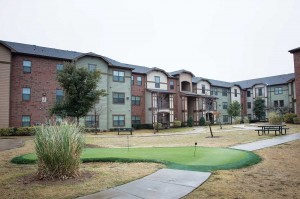“There is no doubt that the impact of the ICP case [against the state agency] was transformative, in terms of changing the way the state funded subsidized housing,” Henneberger said.
Because the ICP case was based on tax-credit housing conditions in Dallas, the judge ordered the state agency to propose a remedy for the Dallas area. But, “the state voluntarily elected to apply the rule changes … across the state,” Henneberger said.

As a result, “We are seeing multifamily affordable tax-credit housing going into neighborhoods that have never seen any affordable housing before,” Henneberger said. “The properties being funded today are largely in neighborhoods where a reasonable person might choose to live,” because of the “quality of the schools, physical safety, the presence of grocery stores, and retail opportunities near jobs.” Places like Sunnyvale and Frisco and Mansfield.
“More importantly, we stopped building housing exclusively where it had been built for 80 years,” Henneberger said, and where the density of such housing was already too great.
In Fort Worth, housing authority officials said, that kind of change, of building tax-credit housing in a variety of neighborhoods, started a few years before the ICP lawsuit and the judge’s ruling.
“We started … in 2007. We had some ideas that [the changes] were going to come,” said Brian Dennison, vice president for development and asset management with the Fort Worth Housing Authority. “For us, that has served as a funding mechanism to allow us to carry out one of our fundamental missions — the de-concentration of low-income housing.”
When the state changed the rules as part of complying with Fitzwater’s order, “We didn’t fight it,” he said. “There is such a huge need for the housing. We used it to our benefit to provide more units.”
Alyce Sykes, public relations manager for the housing authority, said the change has given their tenants the option to live close to their jobs or to stay in far-flung neighborhoods that they are used to — in essence, they are empowered to choose.
Back in Sunnyvale, Daniell Gillaspie said her family understands the value of that ability to choose. She lives in the same tax-credit townhome complex as Niketa Ramsey.
In Mesquite, Gillaspie and her husband and their three kids lived in a subsidized housing development where there was “a lot of crime and a lot of noise.” Maintenance was often a problem, as were vandalism and car thefts. “There were always people doing things that kids shouldn’t be around,” she said. “Here, you don’t see that.”
The low-income tax-credit housing industry is paying a lot of attention to the ICP lawsuits. It’s no wonder, since the federal government estimates that about 85 percent of the billions in corporate equity that finances the projects comes from the banking sector.
Paul Kiernan of Holland & Knight LLP, a law firm that describes itself as a leader in the industry, was quoted last month in the Law 360 publication as saying that a lot of people are “watching nervously.”
The Supreme Court’s ruling in the case against TDHCA could have a huge impact on “the entire world of multifamily and lower-income housing — and ultimately probably other real estate,” he was quoted as saying.
The newsletter of the Affordable Housing Tax Credit Coalition, representing syndicators, investors and others in the industry, noted soon after the filing of the suit against the IRS and Office of the Comptroller of the Currency that the plaintiffs seem to have done their homework and compiled “a substantial amount of evidence.” Although the case centers on Dallas, the newsletter said, “this has the potential of having national implications.”
Daniel said he believes banks have participated in continuing to pack tax-credit housing into bad neighborhoods because it is profitable for them.
“There is more money in doing it in high-poverty zones,” he said. Banks can take a piece of otherwise unsalable land, flip it a couple of times to increase its worth, and end up selling it for a housing project at many times its starting value. In one case in Dallas, he said, one property valued at $20,000 may end up being sold for as much as $1.8 million for tax-credit housing. And, he said, tax credits are higher for developments in high-poverty zones.
Opposition from neighbors has always been a problem with any kind of subsidized housing. In poor neighborhoods, Daniel said, “Nobody fights you. No one is pissed off. … They’d rather have a grocery store, but they aren’t objecting.”
If the Supreme Court agrees with Texas officials and rules that “disparate impact” is not the correct basis for determining if housing patterns are discriminatory, Henneberger said, “You basically kick the props out from under all the good work that is being done right now to break down segregation.”
American cities now are as segregated as they were in the 1940s, he said. “It is a cancer that still infects our cities.” The way to start attacking it, he said, “is with what the government does to maintain it, even before we get to individual acts of discrimination.”
One thing that clearly can be done, because it’s been done since the 1960s, he said, is “to order that federal housing shouldn’t be segregated. We’re still fighting that battle.”











